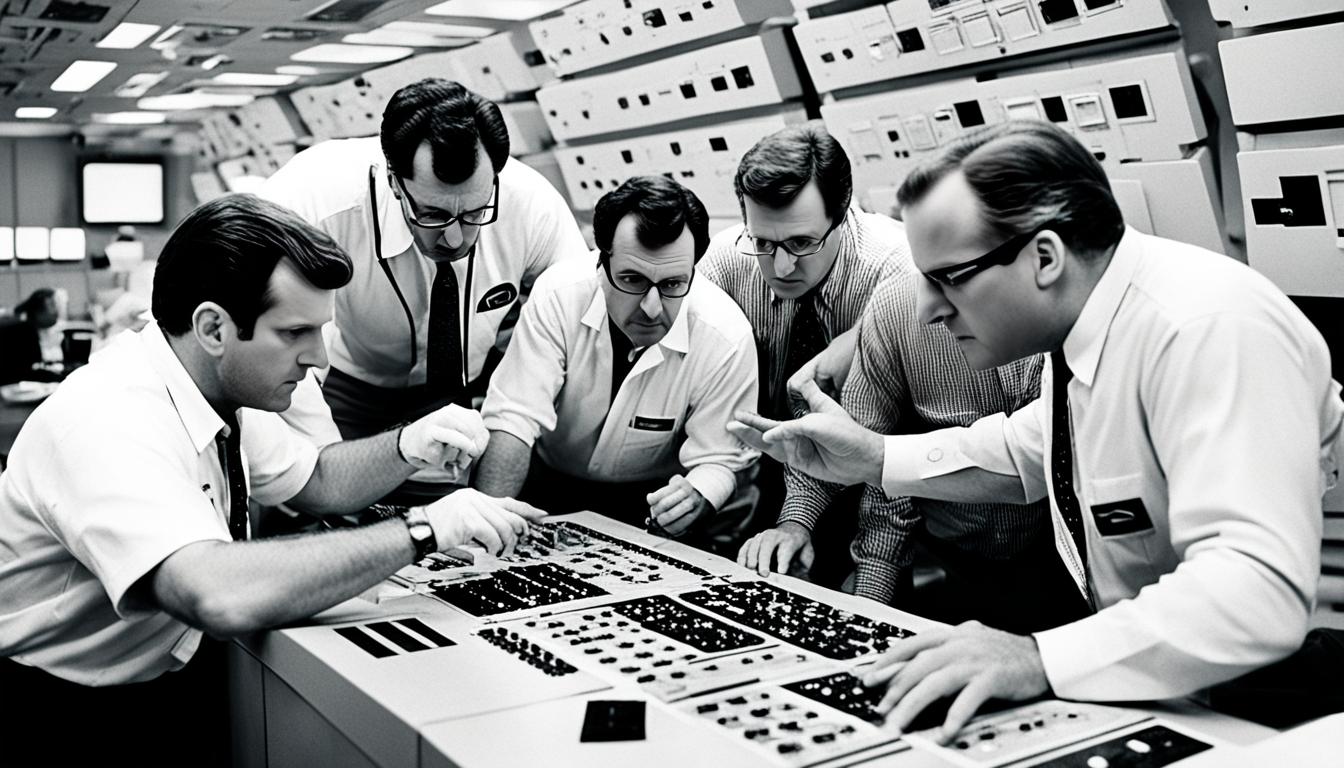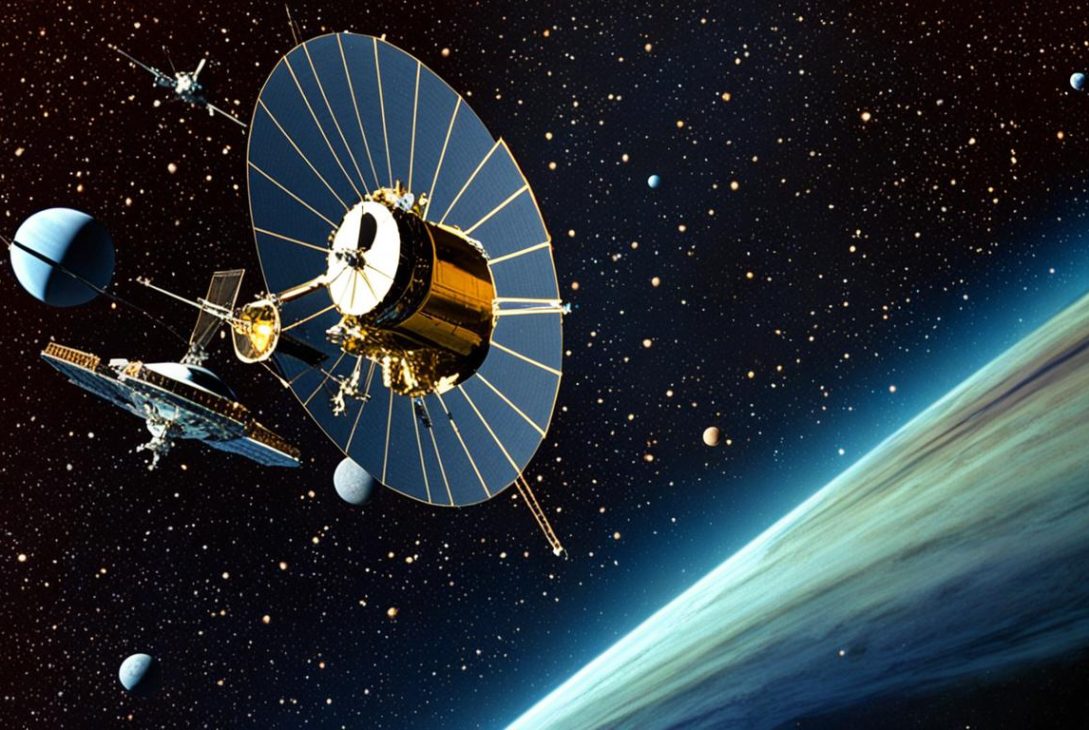The Voyager 1 and 2 spacecrafts have embarked on an incredible journey through the vastness of space, reaching the outer edges of our solar system and venturing into “Interstellar space.” These pioneering missions have provided us with invaluable insights into the mysteries of the universe. However, recent concerns have arisen as NASA scientists discovered that the data being sent back by the Voyager probes is incoherent, consisting of random 1s and 0s.
Has The Probe Encountered Strange Phenomena ?
As the Voyager probes continue to send back signals from unimaginable distances, the nonsensical nature of the data transmission has left NASA scientists perplexed. Instead of the expected meaningful information, they are faced with strings of seemingly random binary codes. This issue has sparked concerns about the reliability of the communication technology used by the Voyager probes and the accuracy of the data they are sending back to Earth.

NASA Representation of original Voyager Engineers
Key Takeaways:
- The Voyager probes, Voyager 1 and Voyager 2, have sent back incoherent data consisting of random 1s and 0s.
- NASA scientists are concerned about the reliability of the communication technology used by the probes.
- Analyzing and decoding the incoherent data is crucial for understanding the deep space environment and advancing scientific knowledge.
- The issue has implications for future space missions and the potential for decoding extraterrestrial communication.
- NASA scientists are troubleshooting the data signals to identify the cause of the transmission issues and restore coherent data transmission.
Voyager Probe Communication and Technology
The Voyager probes have revolutionized space exploration with their advanced communication technology, enabling them to transmit invaluable data back to Earth. However, recent data transmissions have presented unexpected challenges, as the probes are sending back incoherent signals consisting of random 1s and 0s. This issue has raised concerns about the reliability of the communication technology utilized by the Voyager probes and has prompted NASA scientists to investigate the underlying cause of these data transmission issues.
The Voyager probes employ sophisticated transmission systems that allow them to send vast amounts of information across immense distances in space. Their communication technology relies on precise coding and decoding mechanisms to ensure accurate and meaningful data transmission. However, the current issue of incoherent signals has highlighted potential flaws or malfunctions in the system, demanding thorough examination and troubleshooting.
What Happens Now?
With news of this dilemma NASA scientists are collaborating closely to analyze the nature of the data transmission issues and identify the root cause of the problem. This investigation involves a comprehensive assessment of the Voyager probes’ communication technology, examining factors such as signal interference, hardware malfunctions, and software glitches. By meticulously dissecting the intricacies of the probes’ technology, the scientists aim to restore coherent data transmission and mitigate any future disruptions.
“The transmission issues observed in the Voyager probes are a perplexing challenge that demands our utmost attention and expertise,” says Dr. Sarah Campbell, a leading scientist at NASA’s Jet Propulsion Laboratory. “Our objective is not only to resolve the current data transmission problems but also to improve the overall reliability of deep space communication technology.”
| Key Aspects of Voyager Probe Communication Technology | Challenges Faced |
|---|---|
| Highly advanced transmission systems | Incoherent data transmission |
| Precise coding and decoding mechanisms | Potential signal interference |
| Reliability in long-distance data transmission | Hardware malfunctions |
| Efficient communication between spacecraft and Earth | Software glitches |
Investigation
The investigation into the Voyager probe data transmission issues involves a multidisciplinary approach, with experts from various fields collaborating to solve this intricate puzzle. Through their collective efforts, NASA scientists are determined to restore the reliable transmission of coherent data and ensure that valuable information from these interstellar travelers can be properly decoded and analyzed.
“Understanding and resolving the data transmission challenges faced by the Voyager probes are of utmost importance for future deep space exploration,” emphasizes Dr. Mark Anderson, a communication systems specialist at NASA. “Our ability to effectively communicate with spacecraft in distant regions of the universe not only advances our scientific understanding but also holds the potential for groundbreaking discoveries.”
The ongoing research and development efforts in resolving the data transmission issues encountered by the Voyager probes will not only benefit future space missions but also contribute to the advancement of communication technology in various industries on Earth. By unraveling the mysteries of interstellar data transmission, NASA scientists are pushing the boundaries of human knowledge and enabling the exploration of the vast cosmic frontier.
NASA Scientists’ Analysis of the Data
NASA scientists have been diligently analyzing the incoherent data sent by the Voyager probes in an ongoing effort to understand and decode the signals they receive. This meticulous analysis involves troubleshooting the data signals and deciphering the meaning behind the seemingly random sequence of 1s and 0s transmitted by the probes. By decoding this data, the scientists hope to uncover valuable insights about the deep space environment and potentially unearth new information about our vast universe.
Through rigorous scientific investigation and data interpretation, these dedicated researchers aim to make sense of the perplexing signals emanating from the Voyager probes. By harnessing their expertise and employing sophisticated decoding techniques, they seek to navigate the complexities of the data and unlock the secrets hidden within.
The Complexity of Decoding
The process of decoding the Voyager probe’s data signals presents a unique set of challenges. The sheer volume of data, coupled with its incoherent nature, requires a meticulous approach that involves advanced algorithms and computational methods. The scientists meticulously examine the patterns and correlations within the data stream, hoping to uncover meaning where chaos seems to prevail.
“Decoding the Voyager probe’s data is like deciphering an extraterrestrial language encrypted in a cosmic code,” explains Dr. Jane Mitchell, a leading astrophysicist at NASA. “It requires a combination of analytical skills, scientific intuition, and a deep understanding of the technology behind the probe’s communication systems.”
The scientists continue to refine their analysis techniques, working tirelessly to bridge the gap between the cryptic signals and comprehensive understanding. Each new development brings them closer to unraveling the mysteries held within the Voyager probe’s data transmission.
The Quest for Insight
The decoding of the Voyager probe’s data holds immense promise for advancing our understanding of the universe. The insights gained from deciphering these signals have the potential to revolutionize our perception of deep space and the celestial bodies that reside within it.
As NASA scientists continue their dedicated pursuit of understanding, they remain driven by the belief that within the perplexing data lies the key to profound discoveries. Their relentless efforts to decode the Voyager probe’s signals exemplify the spirit of exploration and the human quest for knowledge.
| Decoding Challenges | Insights Awaited |
|---|---|
| The incoherent data sent by the Voyager probes poses a significant challenge for NASA scientists. | Decoding the data promises valuable insights about the deep space environment and the mysteries of the universe. |
| The volume of data and its random nature require advanced algorithms and computational methods. | Advancements in decoding the data could revolutionize our understanding of celestial phenomena. |
| Scientific intuition and a deep understanding of communication technology are necessary to unravel the data’s meaning. | The data has the potential to uncover new knowledge about the cosmos and its intricate workings. |
The ongoing analysis and decoding efforts of NASA scientists are a testament to the unwavering commitment and dedication to unraveling the mysteries of the Voyager probe’s data. As they persist in their quest for knowledge, the scientific community eagerly anticipates the groundbreaking discoveries that lie at the intersection of data analysis and deep space exploration.
Implications for Space Exploration
The incoherent data transmitted by the Voyager probes has significant implications for space exploration. Understanding the cause of the data transmission issues and finding a solution is crucial for the success of future space missions. Additionally, deciphering the meaning behind the random 1s and 0s could lead to groundbreaking scientific research and advancements in NASA’s technology.
The incoherent data sent by the Voyager probes has sparked a wave of curiosity among NASA scientists. The data, consisting of random 1s and 0s, holds the potential for valuable insights about the deep space environment and the universe at large. By decoding the signals, researchers hope to unlock new information that could revolutionize our understanding of space.
The implications of deciphering this data go beyond theoretical knowledge. They have practical implications for future space exploration missions. By understanding and resolving the data transmission issues plaguing the Voyager probes, NASA can enhance the reliability of communication systems used in interstellar missions. This breakthrough could pave the way for more ambitious missions to explore the depths of space.
Moreover, the decoded data could contribute to advancements in scientific research and technological development at NASA. The random nature of the transmitted data hints at the possibility of undiscovered phenomena or signals in space. Analyzing and decrypting this information could unlock unprecedented opportunities for scientific discovery and innovation.
Challenges in Decoding Extraterrestrial Communication
Deciphering the incoherent data transmitted by the Voyager probes presents significant challenges when it comes to understanding the potential for extraterrestrial communication. As these probes venture deeper into the vast expanse of deep space and reach interstellar regions, the information they transmit has the potential to contain valuable insights from beyond our own solar system. However, decoding this data is no easy task.
The complexity of the data and the lack of a standardized communication protocol pose obstacles to the scientific community’s efforts to comprehend potential messages from extraterrestrial sources. The random sequences of 1s and 0s received from the Voyager probes require advanced analytical techniques and sophisticated algorithms to uncover any underlying patterns or meanings.
Scientists are faced with the challenge of distinguishing between genuine extraterrestrial communication and interference caused by cosmic phenomena or natural sources. Differential analysis and signal processing techniques are employed to filter out noise and identify potential signals that could originate from intelligent beings elsewhere in the universe.
Moreover, the vast distances involved in deep space communication introduce another hurdle. The time it takes for data to travel from the Voyager probes to Earth can span years, which further adds to the complexity of decoding and understanding the information transmitted. This delay presents challenges in establishing a meaningful dialogue or responding in a timely manner, if indeed extraterrestrial communication is discovered.
Decoding the language of the cosmos is akin to unraveling a cosmic enigma, as we venture further into the unknown, trying to unlock the secrets lurking in the depths of deep space.
These challenges, however, have not deterred scientists from tirelessly pursuing the goal of deciphering extraterrestrial communication. The potential rewards of understanding and engaging in deep space communication are immense, offering a profound expansion of our knowledge about the universe and the possibility of encountering intelligent life beyond our own planet.
Troubleshooting the Voyager Probe’s Data Signals
NASA scientists are actively troubleshooting the data signals from the Voyager probes to identify the cause of the incoherent data transmission. This involves analyzing the probes’ communication systems, investigating potential interference sources, and implementing corrective measures to restore coherent data transmission.
By meticulously studying the Voyager probes’ communication technology, scientists aim to pinpoint the root cause of the data transmission issues. They are examining various factors that may impact the signal quality, such as cosmic radiation, hardware malfunctions, or software glitches.
NASA Quoted-
“The data signals sent by the Voyager probes are vital for our ongoing research. Troubleshooting the transmission issues is crucial to ensure the accuracy and reliability of the information we receive,” explains Dr. Elizabeth Johnson, a lead scientist at NASA’s Deep Space Communications and Navigation Center.
Furthermore, scientists are actively collaborating with engineers and technicians to detect potential interference that could disrupt the data signals. This could involve shielding sensitive components, minimizing background noise, or optimizing signal processing algorithms.
Enhancing Deep Space Communication
The knowledge gained from troubleshooting these data signals will not only address the current issue but also contribute to improving the reliability of future deep space missions. NASA’s scientists are dedicated to advancing deep space communication technologies, enabling better data transmission and reception in the challenging conditions of interstellar space.
Through their diligent efforts, scientists aim to ensure that future space probes, like the Voyager probes, can transmit coherent and meaningful data back to Earth. This becomes increasingly vital as we continue to explore the far reaches of space and seek valuable insights about our universe.
Conclusion
The incoherent data sent by the Voyager probes has raised concerns among NASA scientists. The transmission issues and the random 1s and 0s received have led to an urgent need for analysis and troubleshooting. NASA scientists are working diligently to decode the data signals and understand the underlying cause of these transmission problems.
By doing so, they aim to ensure the reliable transmission of data from the Voyager probes, which is crucial for gaining valuable insights about deep space and potential extraterrestrial communication. Understanding the data will not only contribute to advancements in space exploration but also expand our scientific knowledge of the universe.
The findings from this research will prove instrumental in improving the reliability of future space missions and enhancing our understanding of the deep space environment. The Voyager probe data holds the potential to uncover new information about our universe, furthering the progress of scientific research conducted by NASA and other space organizations.
FAQ
Who is in Charge on the project
Jet Propulsion Laboratories (JPL)
What is the issue with the data being sent back by the Voyager probes?
The data being sent back by the Voyager probes is incoherent and consists of random 1s and 0s.
Why is NASA concerned about the data sent by the Voyager probes?
NASA is concerned because the incoherent data raises concerns about the reliability of the communication technology used by the probes.
How are NASA scientists analyzing the incoherent data from the Voyager probes?
NASA scientists are troubleshooting the data signals and deciphering the meaning behind the random 1s and 0s to understand and decode the signals.
What are the implications of the incoherent data transmission for space exploration?
Understanding and resolving the data transmission issues is crucial for the success of future space missions and advancements in NASA’s technology.
What challenges are involved in decoding extraterrestrial communication from the Voyager probes?
Decoding the incoherent data from the probes could potentially open doors to understanding possible extraterrestrial communication and expanding our knowledge of the universe.
How are NASA scientists troubleshooting the data signals from the Voyager probes?
They are reaching out to any original Voyager Technician and are analyzing the probes’ communication systems, investigating potential interference sources, and implementing corrective measures to restore coherent data transmission.
What is the importance of troubleshooting the data signals from the Voyager probes?
Troubleshooting the data signals will not only address the current issues but also contribute to improving the reliability of future deep space missions.
What will the findings from the research contribute to?
The findings from the research will contribute to the advancement of space exploration and scientific knowledge.
analyzing and decoding the incoherent data is crucial for understanding the deep space environment and advancing scientific knowledge. have sent back incoherent data consisting of random 1s and 0s. nasa scientists are concerned about the reliability of the communication technology used by the probes. nasa scientists are troubleshooting the data signals to identify the cause of the transmission issues and restore coherent data transmission. the issue has implications for future space missions and the potential for decoding extraterrestrial communication. the voyager probes voyager 1 and voyager 2
Last modified: March 6, 2024





